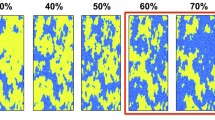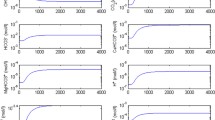Abstract
Carbon dioxide (CO2) injections in geological formations are usually performed for enhanced hydrocarbon recovery in oil and gas reservoirs and storage and sequestration in saline aquifers. Once CO2 is injected into the formation, it propagates in the porous rock by dispersion and convection. Chemical reactions between brine ions and CO2 molecules and consequent reactions with mineral grains are also important processes. The dynamics of CO2 molecules in random porous media are modeled with a set of differential equations corresponding to pore scale and continuum macroscale. On the pore scale, convective–dispersive equation is solved considering reactions on the inner boundaries in a unit cell. A unit cell is the smallest portion of a porous media that can reproduce the porous media by repetition. Inner boundaries in a unit cell are the surfaces of the mineral grains. Dispersion process at the pore scale is transformed into continuum macroscale by adopting periodic boundary conditions for contiguous unit cells and applying Taylor-Aris dispersion theory known as macrotransport theory. Using this theory, the discrete porous system changes into a continuum system within which the propagation and interaction of CO2 molecules with fluid and solid matrix of the porous media are characterized by three position-independent macroscopic coefficients: the mean velocity vector \({\bar{{\bf U}}^{\ast}}\) , dispersivity dyadic \({\bar{{\bf D}}^{\ast}}\) , and mean volumetric CO2 depletion coefficient \({\bar{K}^{\ast}}\) .
Similar content being viewed by others
Abbreviations
- A :
-
A-function (cf. Eq. 19)
- B :
-
B-field (cf. Eq. 23)
- C:
-
Concentration, mol m-3
- D :
-
Dispersivity dyadic, m2 s-1
- D :
-
Molecular diffusion coefficient, m2 s-1
- D g :
-
Diameter of a mineral grain, m
- \({\bar{D}_{\rm x}}\) :
-
Macrotransport dispersivity coefficient in x-direction, m2s-1
- \({\bar{{\bf D}}^{\ast}}\) :
-
Macrotransport dispersivity dyadic coefficient, m2 s-1
- \({{\bf J}_{0}^\infty}\) :
-
Asymptotic probability flux density, m-2 s-1
- K :
-
Permeability tensor, m2
- \({\bar{K}^{\ast}}\) :
-
Macroscale depletion rate, or mean volumetric CO2 sequestration coefficient, s-1
- \({\bar{K}_{\rm x}}\) :
-
Macrotransport depletion rate coefficient in x-direction, s-1
- l :
-
Basic lattice vectors, m
- l :
-
Unit cell length, m
- L:
-
Length of porous bed, m
- p :
-
Pressure, kPa
- \({P_0^\infty}\) :
-
Steady state conditional probability density, fraction
- r :
-
Radial vector, m
- \({\bar{{\bf R}}}\) :
-
Macroscale position vector, m
- R n :
-
Discrete position vector specifying the location of the nth unit cell, m
- s :
-
Ratio of reactive surface to the interstitial space volume, m-1 (m2 m-3)
- sg :
-
Total surface of the mineral grains in a unit cell, m2
- U :
-
Superficial velocity of the fluid, ms-1
- U :
-
Velocity vector in pore space around mineral grain(s), ms-1
- \({\bar{{\bf U}}^{\ast}}\) :
-
Macrotransport velocity coefficient, ms-1
- \({\bar{U}_{\rm x}}\) :
-
Macrotransport velocity coefficient in x-direction, ms-1
- α :
-
Drag coefficient, dimensionless
- \({\eta_{\rm CO_{2}}}\) :
-
CO2 storage/sequestration efficiency, fraction
- κ :
-
Microscopic adsorption or reactivity coefficient, ms-1 (m3 m-2 s-1)
- μ :
-
Fluid viscosity, pa s
- ρ :
-
Density, kg m-3
- σ :
-
Standard deviation, s
- \({\phi}\) :
-
Porosity, fraction
- \({\forall _0}\) :
-
Superficial volume of a unit cell, m3
- \({\forall _g}\) :
-
Volume of mineral grains in a unit cell, m3
- \({\forall_{\rm if}}\) :
-
Interstitial volume in a unit cell, m3
- \({\forall _\infty}\) :
-
Total volume of the bed, m3
- \({\partial \forall _0}\) :
-
Control surface of a unit cell, m2
References
Aris R.: On the dispersion of a solute in a fluid flowing through a tube. Proc. R. Soc. Lond. Math. Phys. Sci 235(1200), 67–77 (1956)
Arts R., Brevik I., Eiken O., Sollie R., Causse E., van der Meer B.: Geophysical methods for monitoring marine aquifer CO2 storage-Sleipner experiences. In: Williams, D.J., Durie, B., McMullan, P., Pailson, C., Smith, A. (eds) Greenhouse gas control technologies, pp. 366–371. CSIRO Publishing, Collingwood, Australia (2000)
Bachu S., Bennion B.: Effects of in-situ conditions on relative permeability characteristics of CO2-brine systems. Environ. Geol. 54, 1707–1722 (2008). doi:10.1007/s00254-007-0946-9
Baines, S.J., Worden, R.H. (eds): Geological storage of carbon dioxide, vol. 233. Geological Society, Special publications, London (2004)
Brenner H.: A general theory of Taylor dispersion phenomena. PCH PhysicoChem. Hydrodyn. 1, 91–123 (1980a)
Brenner H.: Dispersion resulting from flow through spatially periodic porous media. Philos. Trans. R. Soc. London A. Math. Phys. Sci. 297(1430), 81–133 (1980b)
Brenner, H., Edwards, D.A.: Macrotransport processes. Butterworth-Heinemann (1993)
Chadwick R.A., Holloway S., Kirby G.A., Gregersen U., Johannessen P.N.: The Utsira sand, central north sea—an assessment of its potential for regional CO2 disposal. In: Williams, D.J., Durie, B., McMullan, P., Paulson, C., Smith, A. (eds) Greenhouse Gas Control Technologies, pp. 349–354. CSIRO Publishing, Collingwood, Australia (2000)
Comerlati A., Ferronato M., Gambolati G., Putti M., Teatini P.: Fluid-dynamic and geomechanical effects of CO2 sequestration below the Venice lagoon. Environ. Eng. Geosci. XII(3), 211–226 (2006). doi:10.2113/gseegeosci.12.3.211
Gozalpour F., Ren S.R., Tohidi B.: CO2 EOR and storage in oil reservoirs. Oil Gas Sci. Technol. – Rev. IFP 60(3), 537–546 (2005)
Greenkorn R.A., Haselow J.S.: Scaling mixing during miscible displacement in heterogeneous porous media. Transp. Porous Media 6, 607–626 (1991). doi:10.1007/BF00137852
Gunter W.D., Wiwchar B., Perkins E.H.: Aquifer disposal of CO2-rich greenhouse gases: extension of the time scale of experiment for CO2-sequestrating reactions by geochemical modeling. Miner. Petrol. 59, 121–140 (1997). doi:10.1007/BF01163065
Hatiboglu C.U., Babadagli T.: Diffusion mass transfer in miscible oil recovery: visual experiments and simulation. Transp. Porous Media 74, 169–184 (2008). doi:10.1007/s11242-007-9189-1
Holm, L. W., Josendal, V. A.: Mechanisms of oil displacement by carbon dioxide. JPT, December (1974)
Horn F.J.M.: Calculation of dispersion coefficients by means of moments. AIChE J. 17(3), 613–620 (1971). doi:10.1002/aic.690170325
Hovorka S.D., Benson S., Doughty C., Freifeld B.M., Sakurai S., Daley T.M., Kharaka Y.K., Holtz M., Trautz R.C., Seay Nance H., Myer L.R., Knauss K.G.: Measuring permanence of CO2 storage in saline formations: the Frio experiment, Environ. Geosci. 13(2), 105–121 (2006)
Izgec O., Demiral B., Bertin H.: CO2 injection into saline carbonate aquifer formations I: laboratory investigation. Transp. Porous Media 72, 1–24 (2008a). doi:10.1007/s11242-007-9132-5
Izgec O., Demiral B., Bertin H.: CO2 injection into saline carbonate aquifer formations II: comparison of numerical simulations to experiments. Transp. Porous Media 73, 57–74 (2008). doi:10.1007/s11242-007-9160-1
Javadpour, F.: Dispersion and adhesion of blood components in porous media. Ph.D. Dissertation, University of Calgary (2006)
Javadpour F., Fisher D.: Nanotechnology-based micromodels and new image analysis to study transport in porous media. JCPT 47(2), 30–37 (2008)
Javadpour F., Fisher D., Unsworth M.: Nanoscale gas flow in shale gas sediments. JCPT 46(10), 55–61 (2007)
Jiao C.-Y., Hotzl H.: An experimental study of miscible displacements in porous media with variation of fluid density and viscosity. Transp. Porous Media 54, 125–144 (2004). doi:10.1023/A:1026383019300
Kaszuba J.P., Janecky D.R., Snow M.G.: Carbon dioxide reaction processes in a model brine aquifer at 200°C and 200 bars: implications for geologic sequestration of carbon. Appl. Geochem. 18, 1065–1080 (2003). doi:10.1016/S0883-2927(02)00239-1
Moberg R.: The Wyburn CO2 monitoring and storage project. Greenh. Issues 57, 2–3 (2001)
Monger T.G., Ramos J.C., Thomas J.: Light oil recovery from cyclic CO2 injection: influence of low pressure, impure CO2 and reservoir gas. SPE Reserv. Eng. 6, 25–32 (1991)
Oldenburg C.M., Pruess K., Benson S.M.: Process modeling of CO2 injection into natural gas reservoirs for carbon sequestration and enhanced gas recovery. Energy Fuels 15, 293–298 (2001). doi:10.1021/ef000247h
Pamukcu Y.Z., Gumrah F.: Simulating oil recovery during CO2 sequestration into a mature oil reservoir. JCPT 47(8), 34–40 (2008)
Rhodes M.E., Blunt M.J.: Advective transport in percolation clusters. Phys. Rev. E Stat. Nonlin. Soft Matter Phys. 75, 011124 (2007). doi:10.1103/PhysRevE.75.011124
Riaz A., Hesse M., Tchelepi H.A., Orr M. Jr.: Onset of convection in a gravitationally unstable diffusive boundary layer in porous media. J. Fluid Mech. 548, 87–111 (2006). doi:10.1017/S0022112005007494
Rochelle C.A., Czernichowski L., Milodowski A.E.: The impact of chemical reactions on CO2 storage in geological formations: a brief review. In: Baines, S.J., Worden, R.H. (eds) Geological storage of Carbon dioxide, vol. 233, pp. 129–145. Geological Society, Special Publications, London (2004)
Sayegh, S.G., Krause, F.F., Girard, M., DeBree, C.: Rock/fluid interactions of carbonate brines in a sandstone reservoir: Pembina Cardium, Alberta, Canada. SPE Form. Eval. (December), 399–405 (1990)
Shapiro M., Brenner H.: Taylor dispersion of chemically reactive species: irreversible first-order reactions in bulk and on boundaries. Chem. Eng. Sci. 41(6), 1417–1433 (1986). doi:10.1016/0009-2509(86)85228-9
Sohrabi M., Danesh A., Dabir H., Tehrani H., Jamiolahmadi M.: Microscopic mechanisms of oil recovery by near-miscible gas injection. Transp. Porous Media 72, 351–367 (2008). doi:10.1007/s11242-007-9154-z
Taylor G.I.: Dispersion of solute matter in solvent flowing slowly through a tube. Proc. R. Soc. Lond. A Math. Phys. Sci. 219, 186–203 (1953). doi:10.1098/rspa.1953.0139
Teng H., Yamasaki A.: Mass transfer of CO2 through liquid CO2-water interface. Int. J. Heat Mass Transf. 41, 4315–4325 (1998). doi:10.1016/S0017-9310(98)00173-2
Yang C., Gu Y.: Accelerated mass transfer of CO2 in reservoir brine due to density-driven natural convection at high pressures and elevated temperatures. Ind. Eng. Chem. Res. 45, 2430–2436 (2006). doi:10.1021/ie050497r
Yang D., Tontiwachwuthikul P., Gu Y.: Interfacial interactions between reservoir brine and CO2 at high pressures and elevated temperatures. Energy Fuels 19, 216–223 (2005). doi:10.1021/ef049792z
Zick A.A., Homsy G.M.: Stokes flow through periodic arrays of spheres. J. Fluid Mech. 115, 13 (1982). doi:10.1017/S0022112082000627
Author information
Authors and Affiliations
Corresponding author
Rights and permissions
About this article
Cite this article
Javadpour, F. CO2 Injection in Geological Formations: Determining Macroscale Coefficients from Pore Scale Processes. Transp Porous Med 79, 87–105 (2009). https://doi.org/10.1007/s11242-008-9289-6
Received:
Accepted:
Published:
Issue Date:
DOI: https://doi.org/10.1007/s11242-008-9289-6




